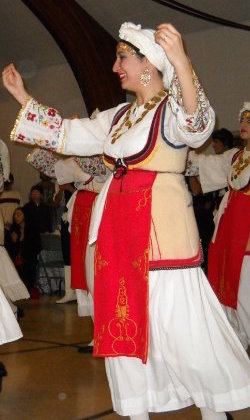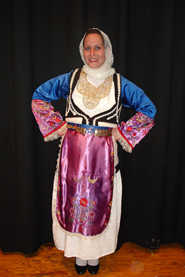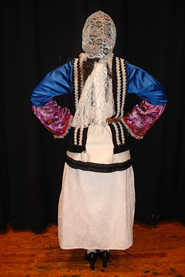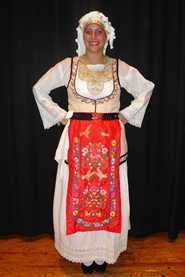
Mainland Greece
The region of Mainland Greece is also referred to as Central Greece. It consists of the region north of Attica, south of Thessaly and Epirus, and the island of Euboea. Its capital is Lamia and other major towns are Arachova, Atalanti, Chalkida, Karpenisi, Livadeia, and Thebes.
Popular dances from Mainland Greece
Euboeotikos (Euboea), Kavontoritikos (Euboea), Miloniatikos (Euboea), and Syrtokalamatianos/Kageli
Costumes from Mainland Greece
| This costume originated from Arahova and was worn throughout the regions of Amfissa and Distomo. Throughout the years, this costume has simplified in regard to the embroidery and the headscarf. The jacket, called the “sigouni”, was woven with heavy woolen fabric and embroidered with red thread (the “lazour”). The bridal and festive “sigouni” was lined with felt and embroidered with gold braiding. Significant research has been conducted on this costume by the folklorist Angeliki Hatzimichalis. |  |
 |
||
| The traditional costumes of the area of Messapia, Euboea have great variety in colors and styles. This costume, from the town of Psahna, Euboea, is one of the many variations of the local dress of Euboea and specifically Messapia. The embroidery on the large chemise indicates the age of its married wearer. The embroidered cuffs (the “manikes) are sewn to one of the various chemises. The sleeveless jacket (the “sigouni”), which is worn for the first time on the wedding day, is white and embroidered in black. The apron is embroidered and decorated with ribbons and fringes. The headdress is a silk white scarf (the “bolia”). Gold jewelry typically accompanies the costume as well. |  |
 |
||
| This festive and bridal costume from Kymi, Euboea was worn beginning in 1850. One of the characteristic features of the costume is the almost total lack of jewelry, which was interesting since the men from Kymi were typically very wealthy sailors and traders. The costume consists of two shirts that were made from fine, imported silk. The hair was usually arranged in two braids that fell below the waist in order to decorate the back of the costume. The head was covered by a headscarf, which was adorned with decorations such as lace and beads. |  |
 |
||
| The costume with the pleated skirt (the “foustanella”) was first established as the formal court attire by Otto, the first king of Greece. The main component of the costume is the long “foustanella”, which usually was knee-length. The gold-embroidered belt (the “selahi”) was worn on top of a red silk sash. The costume typically had multiple jackets: the waistcoat (the “gileki”), the “fermeli” with sleeves, and the waistcoat worn on top, called the “fermedogileko.” The fez was customary to both Ottoman and Greek men’s wardrobe since the 17th century. |  |
 |
||
| This is the festive costume from the city of Livadeia in central Greece. Due to its proximity to Arahova, the costume has many aesthetic similarities to the costumes of Arahova, Amfissa, and Distomo. The costume from Livadeia differentiates itself from the aforementioned costumes by its colorful apron embroidered with flower motifs. It is also composed of a beige jacket (the “sigouni”), which is embroidered with black, red, and gold threads. The headscarf, upon which hung white pompons, was traditionally made from white silk. |  |
 |
||
